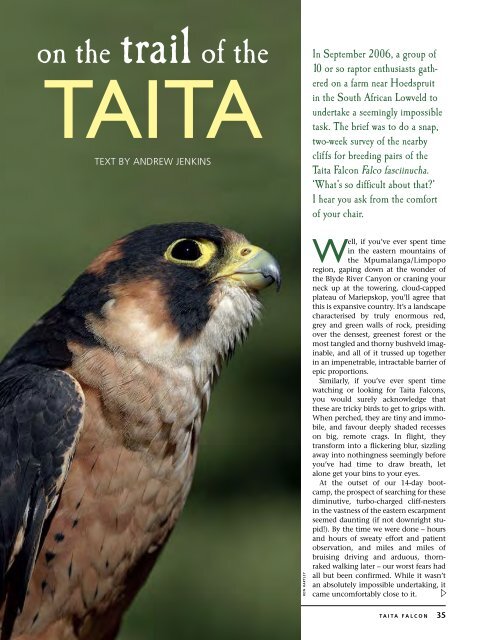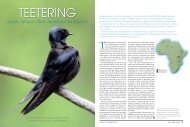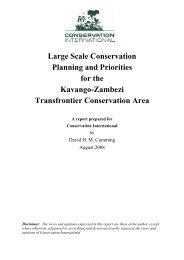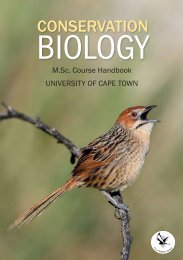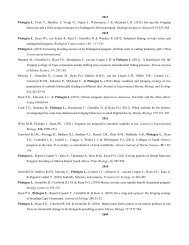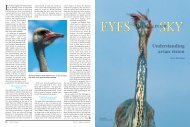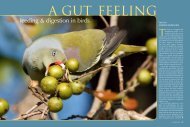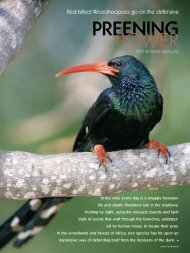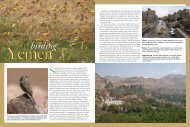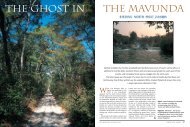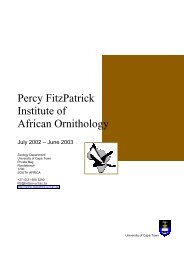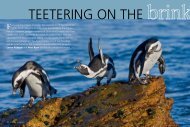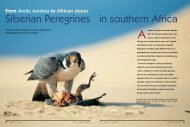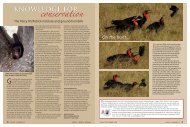Birds & Birding 12(3)
Birds & Birding 12(3)
Birds & Birding 12(3)
You also want an ePaper? Increase the reach of your titles
YUMPU automatically turns print PDFs into web optimized ePapers that Google loves.
on the trail of the<br />
Taita<br />
Text by Andrew Jenkins<br />
Bb<br />
In September 2006, a group of<br />
10 or so raptor enthusiasts gathered<br />
on a farm near Hoedspruit<br />
in the South African Lowveld to<br />
undertake a seemingly impossible<br />
task. The brief was to do a snap,<br />
two-week survey of the nearby<br />
cliffs for breeding pairs of the<br />
Taita Falcon Falco fasciinucha.<br />
‘What’s so difficult about that?’<br />
I hear you ask from the comfort<br />
of your chair.<br />
ron hartley<br />
Well, if you’ve ever spent time<br />
in the eastern mountains of<br />
the Mpumalanga/Limpopo<br />
region, gaping down at the wonder of<br />
the Blyde River Canyon or craning your<br />
neck up at the towering, cloud-capped<br />
plateau of Mariepskop, you’ll agree that<br />
this is expansive country. It’s a landscape<br />
characterised by truly enormous red,<br />
grey and green walls of rock, presiding<br />
over the densest, greenest forest or the<br />
most tangled and thorny bushveld imaginable,<br />
and all of it trussed up together<br />
in an impenetrable, intractable barrier of<br />
epic proportions.<br />
Similarly, if you’ve ever spent time<br />
watching or looking for Taita Falcons,<br />
you would surely acknowledge that<br />
these are tricky birds to get to grips with.<br />
When perched, they are tiny and immobile,<br />
and favour deeply shaded recesses<br />
on big, remote crags. In flight, they<br />
transform into a flickering blur, sizzling<br />
away into nothingness seemingly before<br />
you’ve had time to draw breath, let<br />
alone get your bins to your eyes.<br />
At the outset of our 14-day bootcamp,<br />
the prospect of searching for these<br />
diminutive, turbo-charged cliff-nesters<br />
in the vastness of the eastern escarpment<br />
seemed daunting (if not downright stupid!).<br />
By the time we were done – hours<br />
and hours of sweaty effort and patient<br />
observation, and miles and miles of<br />
bruising driving and arduous, thornraked<br />
walking later – our worst fears had<br />
all but been confirmed. While it wasn’t<br />
an absolutely impossible undertaking, it<br />
came uncomfortably close to it.<br />
<br />
june/july 2007<br />
taita falcon<br />
35
Top Taita country? Hebronberg and the<br />
huge cliffs of the Mpumalanga escarpment<br />
stretch away to the south of Mariepskop.<br />
Above Part of the Taita survey team<br />
between stints in the field. From left: Alan<br />
Stephenson, Lucia Rodrigues, Alan Harvey,<br />
Andrew Jenkins and Anthony van Zyl,<br />
with Strijdom Tunnel Taita guide, Michael<br />
Kumako.<br />
So, if we knew from the outset that it was<br />
going to be such a struggle, what made us<br />
take on this seemingly hopeless mission?<br />
Well, for all its difficulties and challenges,<br />
the Taita is a pretty neat bird and, for people<br />
with a penchant, even a passion, for<br />
falcons, the chance to spend some time in<br />
this awesome environment, possibly finding<br />
and watching Taitas doing their thing,<br />
was probably sufficient motivation.<br />
But more importantly, the Taita Falcon<br />
is a very rare and poorly known species,<br />
and our main goal was to figure out how<br />
many pairs actually reside in the escarpment<br />
area. This was a requirement initially<br />
identified by a meeting of the Taita<br />
Falcon Interest Group, held in the area in<br />
February 2005 under the auspices of the<br />
Endangered Wildlife Trust’s <strong>Birds</strong> of Prey<br />
Working Group (BoPWG). While there are<br />
only two confirmed breeding sites (one of<br />
which is well known to birders, situated<br />
near the J.G. Strijdom Tunnel on the Abel<br />
Erasmus Pass), there are enough incidental<br />
sightings of Taitas from other parts<br />
of the escarpment to suggest that there<br />
are more pairs in the area. The meeting<br />
concluded that it was a priority to get a<br />
more accurate idea of the size and relative<br />
importance of the local population.<br />
With probably fewer than 40 known and<br />
currently active Taita Falcon nest sites in<br />
the world, if we could increase the escarpment<br />
tally to between five and 10 pairs,<br />
then the South African birds could emerge<br />
as globally significant and worthy of special<br />
consideration and protection.<br />
The team assembled to do the survey<br />
boasted a wealth of raptorand<br />
falcon-watching experience.<br />
Alan Kemp and Dave Allan were probably<br />
the most established and widely<br />
respected names, while Anthony van<br />
Zyl, Ara Monadjem and I made up the<br />
slightly younger research scientist contingent.<br />
André Botha, manager of the<br />
BoPWG, brought NGO administrative<br />
anthony van zyl (2)<br />
muscle and considerable birding skills<br />
to the party, while Alan Stephenson and<br />
Alan Harvey offered valuable, slightly<br />
different perspectives as falconers with<br />
years of experience with wild falcons.<br />
Lucia Rodrigues, an amateur and relative<br />
novice to this kind of work, provided<br />
morale-boosting enthusiasm, dogged<br />
determination and much-needed organisational<br />
acumen gleaned from a previous<br />
career in the corporate world. Dave<br />
Rushworth, environmentalist and longtime<br />
resident in the Hoedspruit area,<br />
was another vital cog in the survey<br />
machinery. Having blazed many of the<br />
surrounding hiking trails, and walked<br />
and birded in even the most out-of-theway<br />
parts of the escarpment mountain<br />
chain, Dave is a phenomenal source of<br />
exactly the kind of local knowledge we<br />
needed to get the survey done quickly<br />
and effectively. Together with former<br />
provincial ornithologist Peter Milstein,<br />
Dave was the first to see Taitas in South<br />
Africa during the late 1980s, and has<br />
since recorded the species at a number<br />
of localities. We built our initial survey<br />
plan around these sightings, taking into<br />
consideration Dave’s ‘feel’ for where additional<br />
breeding pairs were most likely to<br />
be found.<br />
We had originally intended to look<br />
for Taitas along the entire length of the<br />
main eastern escarpment, from Graskop<br />
in the south to the Strijdom Tunnel in<br />
the north. However, we soon realised that<br />
this was an unreasonable expectation, and<br />
opted rather to focus on the cliffs between<br />
Scotland Hill (just south of Mariepskop)<br />
and a point just north of the tunnel. Our<br />
modus operandi was simple: the 4–8 team<br />
members available on any given day were<br />
divided into groups of two, and each<br />
pair was posted at a possible nest site,<br />
equipped with binoculars, spotting scope,<br />
GPS and notebook, for anything up to<br />
seven to eight hours at a time, constantly<br />
on the lookout for signs of resident Taita<br />
Falcons, as well as any other cliff-nesting<br />
raptors present in the vicinity.<br />
Quite often, good observation points<br />
either above or below the cliffs in question<br />
were extremely difficult to access,<br />
and we struggled to reach them in time<br />
to catch the Taitas’ anticipated early<br />
morning activity peak, even on the single,<br />
notable occasion when we used a<br />
helicopter to drop us in position. We also<br />
did some helicopter survey work along<br />
the big cliffs of the main canyon area, but<br />
with very limited success, mostly because<br />
of weather and helicopter problems. In<br />
spite of these and other logistical and<br />
practical difficulties, which were inevitable<br />
given the nature of the ground we<br />
were trying to survey, we achieved pretty<br />
good coverage of our chosen area. We<br />
accumulated more than 50 person-days<br />
of effort at nearly 40 observation points<br />
along the escarpment, each situated in<br />
good view of a minimum of 50 potential<br />
Taita nest cliffs, spread along approximately<br />
40 kilometres of very high cliffs.<br />
The survey started at a canter with<br />
the location of a ‘new’ pair of<br />
adult Taitas on our first full day<br />
out. The birds were firmly established on<br />
ron hartley<br />
A pair of adult Taita Falcons, held in a<br />
captive-breeding pen in Zimbabwe.<br />
Mount Elgon, Uganda Four breeding<br />
pairs, among numerous pairs of Peregrines<br />
and Lanners, recorded in the mid-1980s<br />
(Peter Möller), but absent from the area in<br />
a subsequent follow-up survey.<br />
Tanzania Scattered sightings and<br />
breeding likely but not confirmed.<br />
Zambia & Malawi Scattered sightings<br />
but only one documented breeding record,<br />
from the Mwanza district of Malawi.<br />
Zimbabwe At least 15 breeding pairs and<br />
perhaps as many as 50, although known<br />
strongholds such as the Batoka Gorge on<br />
the Zambezi are now in decline (Ron Hartley).<br />
taita falcon distribution<br />
a massive cliff on the northern extremity<br />
of the canyon and, on the morning<br />
we found them, were going through all<br />
their nuptial behaviours as a precursor<br />
to egg-laying. The excitement this find<br />
created gave the project a vital initial<br />
impetus, which was largely maintained<br />
throughout the fortnight. This despite<br />
the fact that we had no further success<br />
until day 11, when Dave Allan’s inspired<br />
decision to check a low, riverine site,<br />
with distinctly different features to the<br />
habitat search image we’d been locked<br />
on up until then, paid off. He and his<br />
wife, Debbie, saw a single Taita Falcon<br />
aggressively mobbing a pair of Verreaux’s<br />
Eagles at this surprisingly small cliff, and<br />
a subsequent watch confirmed that a pair<br />
of Taitas was in residence and apparently<br />
incubating a clutch of eggs. We had our<br />
second (and final) new nest!<br />
Overall, the survey was a qualified success.<br />
Starting with a population of two<br />
known Taita Falcon sites, each with a history<br />
of breeding going back to the late ’80s<br />
or early ’90s, we were able to confirm these<br />
as still current and add another two confirmed<br />
nest sites. As testimony to the general<br />
thoroughness of the exercise, we also<br />
located three active Peregrine Falcon nest<br />
sites, <strong>12</strong> pairs of Lanners, 23 pairs of Rock<br />
Kestrels, five Verreaux’s Eagle sites, three<br />
Black Stork sites, five Jackal Buzzard sites<br />
Ethiopian Highlands Sightings<br />
from both southern Ethiopia and<br />
south-eastern Sudan, but no confirmed<br />
breeding, despite repeated<br />
surveys in the late 1990s (Simon<br />
Thomsett).<br />
Kenya Scattered sightings<br />
across the country, and at<br />
least seven possible or<br />
definite nest sites. Probably<br />
overlooked in the more<br />
remote, mountainous regions.<br />
(Simon Thomsett)<br />
Northern Mozambique<br />
Sightings and at least one<br />
confirmed breeding pair,<br />
with the potential for more<br />
(Ara Monadjem and others).<br />
South Africa Occasional<br />
sightings, and two known<br />
breeding sites before the<br />
2006 survey.<br />
and two pairs of White-necked Ravens.<br />
Under the circumstances, we are reasonably<br />
happy with these results. We doubled<br />
the known population of Taitas for South<br />
Africa, and plotted more than 50 nests of<br />
other important cliff-nesting birds, including<br />
18 sites of Red-listed species.<br />
However, we fell tantalisingly short of<br />
our self-imposed minimum target of five<br />
pairs of Taitas, and feel confident that a<br />
repeat survey in 2007, particularly if<br />
we include a shortlist of key locations<br />
which we didn’t visit or survey fully in<br />
2006, could very well reveal another<br />
pair or two. This would further support<br />
our view that the area holds a bona fide,<br />
and very valuable, population of these<br />
impressive, fascinating, but frustrating<br />
little falcons.<br />
<br />
ACKNOWLEDGEMENTS<br />
Our sincere thanks go to The Peregrine Fund,<br />
the African Bird Club and Glendower Whisky<br />
for their financial support of this project. We<br />
would also like to extend our thanks to Hannes<br />
Marais, warden of the Blyde River Canyon<br />
Nature Reserve, who spent some time with us in<br />
the field and took us to parts of this wonderful<br />
park which are generally closed to the public;<br />
to Michael Kumako, the Taita guide at the<br />
Strijdom Tunnel, for his valuable input; and to<br />
all the private landowners who gave us unlimited<br />
access to their farms along the escarpment.<br />
36 taita falcon africa – birds & birding<br />
june/july 2007<br />
taita falcon 37


